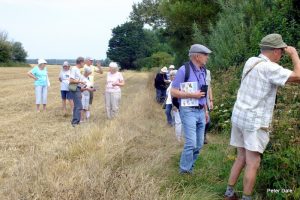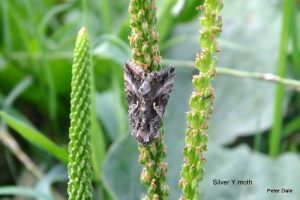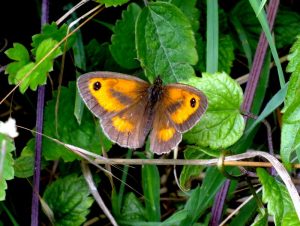Tag Archives: Events
The Long Walk Home – 26 July
After a gap of several years Michael Blencowe returned to Ferring Conservation Group to regale members and visitors alike with tales of his epic walk of 348 miles from his current home in Sussex back to his childhood roots in Devon.
Now a freelance naturalist, author and wildlife guide, Michael felt compelled to complete this walk after suffering what he was told to be a heart attack, which thankfully turned out to be a false alarm. Michael has a unique ability to educate and entertain us all at the same time and in March 2023 laden with an enormous rucksack containing 15 maps, numerous blister packs, a jar of Bovril etc, and with the aid of walking poles, he set out on the first leg of his journey walking from Small Dole to Amberley. Blistered feet were a big problem for Michael and set in soon after departure, so Michael’s blister packs were soon depleted.
Along the route Michael visited the charming 13th century church of St Andrew’s in Didling known as the Shepherd’s Church nestled in the South Downs in an isolated spot – it has no electricity supply and is lit by candles. When a shepherd was buried, traditionally a piece of sheep’s wool was placed in his folded hands – this was to ensure that at the Pearly Gates, St Peter would understand that the shepherd was often absent from church as he had to tend his sheep.
Michael delighted in the wildlife that he encountered along the route including Yellowhammers, boxing Hares, Redwing, Fieldfare and Peregrine Falcons to name but a few. On reaching Dorset on Day 10 with over 100 miles covered, Michael woke to find a thick layer of snow had obliterated many landmarks making his journey difficult to navigate. As the snow melted and with a splendid view of the Jurassic coastline visible he made his way inland to the town of Bridport. The South West Coastal Path lay 14 miles away towards Lyme Regis and then a further 10 miles into Beer and his home county of Devon.
It was around this time that Michael decided to exchange his large backpack for a much smaller version which made his walk through to Dartmouth much easier. Seeing much of the Gorse in bloom lifted Michael’s spirits as he continued his journey to the town of Salcombe and in doing so completing approximately 300 miles. Passing the Start Point Lighthouse at Kingsbridge, then through Bantham, Bigbury with views of Burgh Island, Ermington, Elburton and Yealmpton and finally arriving at his childhood home in the city of Plymouth – 22 days and 348 miles later. With great relief he had achieved his goal but he did note that the journey back to Michael’s home in Sussex by car took only 4 hours.
Graham Tuppen presented the Nature Notes slot after the usual break for refreshments by showing members a series of excellent photographs including a Cinnabar moth on a Ragwort plant, a Cricket on a Marigold flower and the beautiful wild flower bed in the Glebelands recreation ground (all of the wild flower beds in the village have been exceptional this year). A photograph of the blue flax flowers growing in the fields of Chatsmore Farm plus a six-spot Burnet Moth on a Round-headed Rampion plant. There were also reports of Little Egrets and Herons on the Ferring Rife, together with sightings of Greenfinch, Goldfinch, Long-tailed Tits and a Buzzard.
A planning update was delivered by Stephen Abbott to conclude the meeting, with no further planning applications submitted.
The additional house in the garden of 44, Ferringham Lane had been refused by Arun DC and an Arun proposal to increase the number of beach huts along this stretch of the coastline is under consultation with the relevant Parish Councils, including Ferring.
July events
Sunday 14 July – litter clean up of central part of Ferring Village. Please meet on Village Green at 11am, and equipment and high vis jackets will be provided. We plan to clean up the Green and Glebelands Rec (and surrounds), and by coincidence this is the day after the Ferring Festival so a good opportunity to remove any litter.
We will also be having stand at the Festival in conjunction with Ferring History Group on the day before (Saturday 13th), and we’ll be in a marquee at Glebelands. This will be between 11am and 4pm.
On the following Tuesday (16th), we will be carrying out our contribution to the national Big Butterfly Count organised by Butterfly Conservation, and as last year, this one will be at Cissbury Ring, where we’ll be meeting at the top car park at 11am. This site is one of the very best for butterflies (both in numbers and different species) in the whole of the South East, so a good opportunity to learn about them while counting for the survey. Feel free to bring a picnic, especially if the weather is nice.
*UPDATE AS OF MONDAY 1700 – the butterfly count tomorrow (Tuesday) has been postponed as the weather forecast is not conducive for the appearance of butterflies. The provisional replacement date will now be 1100 on Thursday 25 July, and this will take place unless we advise of another weather related change*
Bluebell Walks
On a warm Saturday 13th April, 12 members of the group met in Clapham Church car park. Led by Graham Tuppen, we walked through the woods, admiring the bluebells, wood anemones, celandines, greater stitchwort and primroses. Despite searching, no early purple orchids were spotted.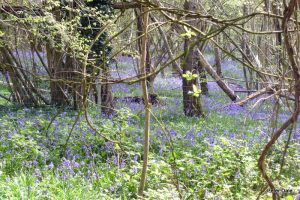
A diversion from the main path took us to a magnificent beech tree, which apparently has a somewhat questionable history, and then to a delightful spot at the woods’ edge overlooking Long Furlong and Blackpatch Hill.
A lot of coppicing has been carried out recently, partially with the aim of encouraging silver-washed fritillary butterflies by improving the habitat for their caterpillars’ food plants. We finished with a look around Clapham Church.
A small group of members met on a delightfully sunny Monday 29th April morning, for a walk to see the bluebells and early purple orchids in Patching woods and part of the Norfolk Estate, again guided by Graham.
The bluebells were still lovely, and the early purple orchids were putting on a great show. 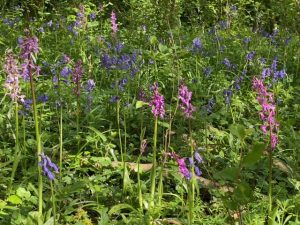
Other flowers spotted in the woods and near the village were greater stitchwort, a few late wood anemones, celandines, wood spurge, red campion, yellow archangel, herb robert, alkanet, some Californian poppies, and speedwell.
Jackie Seymour led the butterfly spotting, with large whites, brimstones, speckled wood, red admiral, peacock and orange tips. An interesting black and red froghopper insect was also spotted.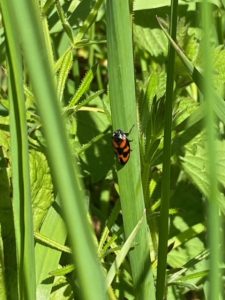
Birds included a red kite and buzzards. (Photos by Peter Dale and Lynda Monger)
Late April and May events
In addition to the main meeting this coming Friday (26th) at Ferring Village Hall at 2.30pm on the Broadwater and Worthing Cemetery, we have the following events coming up:
1. An extra Bluebell Walk – this time in Patching Woods next Monday 29th April, meeting at the usual place in France Lane just south of the main village at 1030am. We should be seeing some early Orchids there in addition to the Bluebells. Please note there are a number of stiles to cross, and it may still be muddy in places.
2. Monthly Community Project morning – Thursday 2nd May – an hour’s work, meeting at the Sea Lane boat at the sea end of the road at 10am. The plan is to dig out and replant the boat with fresh soil etc, plus if time, some work at the Raised Shingle Beds further along Patterson’s Walk. Please bring a spade and trowel etc if you have them.
3. Annual Memorial Visit to Warnham Nature Reserve near Horsham (just off A24 and signposted) to remember our good friends Tricia and Mike Hall – Friday 10th May, meeting there at the opening time of 10am. Please note there is a small entrance fee (cards only) and a coffee shop plus facilities. Please lift share if at all possible.
4. A small impromptu repeat of the above Warnham visit to anybody who can’t make it on that date. This one will be the following week on Thursday 16th May, also meeting at 10am.
5. First Beach Clean of the year – Sunday 19th May, meeting at the east end of the Bluebird Cafe car park as usual at 11am. All equipment will be provided.
A lot going on for your interest then, and if weather might be an issue on the day, please check the website for any updates.
Presentation on Ferring’s WWII defences including the Pill Box
Some pictures of the recent excellent presentation by committee member Pete Coe on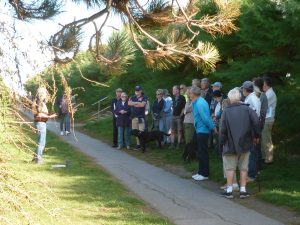 Ferring’s WWII defences, and particularly the Pill Box on Patterson’s Walk. This included an update on its current joint restoration project with Ferring History Group, which is progressing well.
Ferring’s WWII defences, and particularly the Pill Box on Patterson’s Walk. This included an update on its current joint restoration project with Ferring History Group, which is progressing well.
For information, Pete has also written a book on the subject which should be published before Christmas with all proceeds going to the restoration fund. Watch out for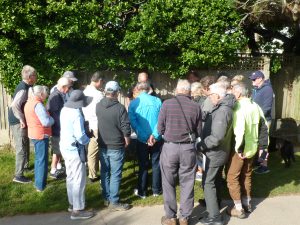 more details of the exact publication date and how to obtain a copy.
more details of the exact publication date and how to obtain a copy.
Ferring History Group and Ferring Conservation Group – (A Joint Project to clear and make safe the Pill Box on Patterson’s Walk)
As one of the few remaining Pill Box beach defences along the West Sussex coastline,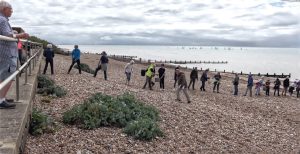 this strategic structure was erected by the Royal Engineers in 1941 as part of the beach defences known as the coastal crust. Ferring lies in the middle of the West Sussex section of the German invasion plans, code named Operation Sea Lion.
this strategic structure was erected by the Royal Engineers in 1941 as part of the beach defences known as the coastal crust. Ferring lies in the middle of the West Sussex section of the German invasion plans, code named Operation Sea Lion.
It was felt by both Groups that it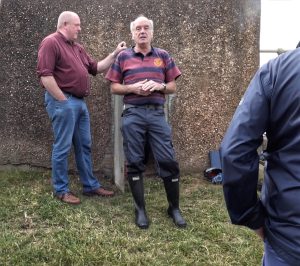 would be worthwhile to dry out and make the Pill Box safe inside as it would be of interest to residents and to local school children, especially year six pupils as WW2 is taught as part of the National Curriculum.
would be worthwhile to dry out and make the Pill Box safe inside as it would be of interest to residents and to local school children, especially year six pupils as WW2 is taught as part of the National Curriculum.
The steel entrance door had to be opened and a new lock fitted before the nine inches of water that covered the floor could be removed. As the water could not be pumped out it was tested to ascertain its source and it proved that this was rain water, and had not been flooded by seawater during high tides.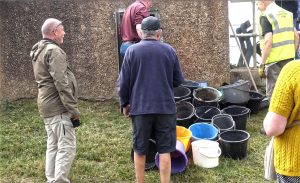
With guidance from Ferring Conservation Group committee member Pete Coe, himself a former officer of the Royal Engineers, a line of volunteers each with a bucket met on Patterson’s Walk on the morning of Friday 28th July. Under Pete Coe’s direction a human chain was formed between the Pill Box along the beach towards the sea and the muddy water was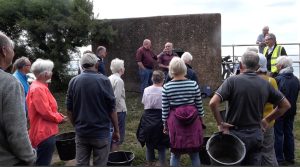 removed and bucketful after bucketful was passed along the line and dispersed along the beach. Grateful thanks go to West Worthing MP Sir Peter Bottomley and Arun district councillors Mark Turner and Lesley-Anne Lloyd together with the many other volunteers, including one of the youngest members of Ferring Conservation Group, 11 year old Eoin Kearns, whose strength and enthusiasm matched that of any of the adults present.
removed and bucketful after bucketful was passed along the line and dispersed along the beach. Grateful thanks go to West Worthing MP Sir Peter Bottomley and Arun district councillors Mark Turner and Lesley-Anne Lloyd together with the many other volunteers, including one of the youngest members of Ferring Conservation Group, 11 year old Eoin Kearns, whose strength and enthusiasm matched that of any of the adults present.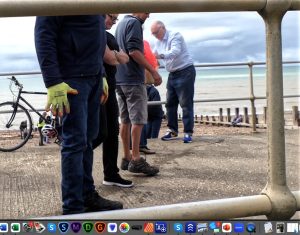
Once the roof had been properly sealed the next stage of the project was to open up the bricked-up embrasures where the guns were mounted and install either vandal-proof glass or Perspex. This will enable visitors to appreciate the view the soldiers had from inside the Pill Box.
As well as leading the practical work Pete Coe will continue with further research with assistance from Martin Mace the author of Frontline Sussex: Defence Lines of West Sussex 1939-1945 who was also one of the volunteers helping with the practical work on the 28th July.
Butterfly Count at Cissbury Ring
On Tuesday 18th July members of Ferring Conservation Group, led by Clive Hope,Graham Tuppen and Jackie Hall, met at Cissbury Ring to take part in the Butterfly Conservation’s Big Butterfly Count.
It was a lovely sunny day, with only a gentle breeze, so the conditions were favourable and in all 19 varieties of butterflies, 3 of moths, with numbers of some species well into the 20s. The Group saw Large, Small and Marbled White, Brimstone, Small Copper, Meadow Brown, Gatekeeper, Painted Lady, Red Admiral, Common and Chalkhill Blue, Brown Argus, Speckled Wood, Peacock, Small Tortoiseshell, Wall Brown, Dark Green Fritillary, and Small and Essex Skipper Butterflies, and 6-Spot Burnet, Silver Y and Common Crimson and Gold Moths.
The wildflowers were many and varied, and birds spotted included Goldfinches, a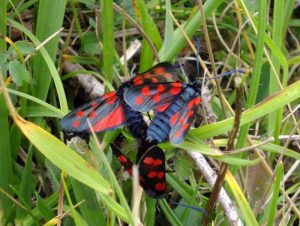 Kestrel, Red Kite and a young Redstart.
Kestrel, Red Kite and a young Redstart.
The Group also saw the New Forest ponies that grazing freely playing an important part in restoring the iconic features of the landscape. The ponies eat away at dead grass and overgrowing shrubs which help to make space for wild flowers and allows wildlife to bloom.
Everyone agreed that the event was a delightful 2 hours of gentle exercise in a lovely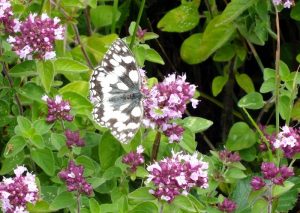 setting with great company.
setting with great company.
(Photographs courtesy of Peter Dale)
Summer Social
We’re holding our annual Summer social on the evening of Saturday 19 August, and this year it will be at the St. Andrew’s Church Centre, starting at 6.30pm.
There will be a choice of hot buffet main meals, with salads and bread etc, then a choice of desserts and cream to follow, plus one free drink will be included. There will also be a series of fun quizzes with prizes to entertain you and a raffle, so should be an evening of good company and good food as usual.
Tickets are priced at £12.50 per person. These can be bought at our stall at the Ferring Village Fair at Glebelands recreation ground next Saurday 8 July between 11am and 4pm, or at our next meeting at the Village Hall on Friday 28 July. Alternatively, you can ring David Bettiss on 07502 176374 or send a message via the Contact button on this website to arrange purchase outside the above two occasions. We would ask that you pay at the time as this year we won’t be able to save tickets to be paid “on the door” on the night.
2023 Beach Clean (and Rife Clean) dates
Please note that our four clean up dates for this year (2023) have been arranged, and details are available in the Beach Clean Dates section of this website. These will now be held on Sundays, and not Saturdays as previously. The first one will be the Rife clean up on Sunday 26 March at 11am.

